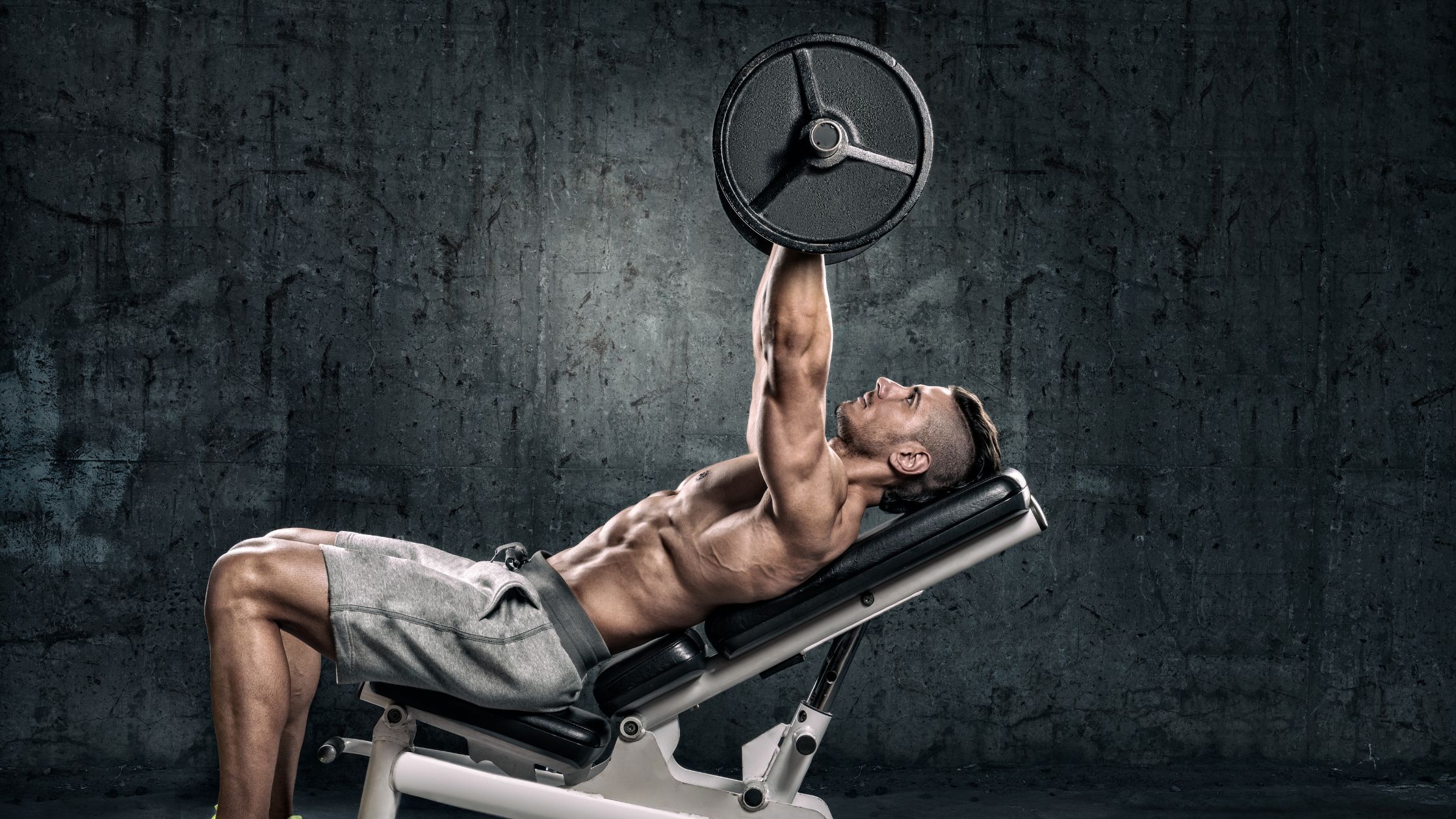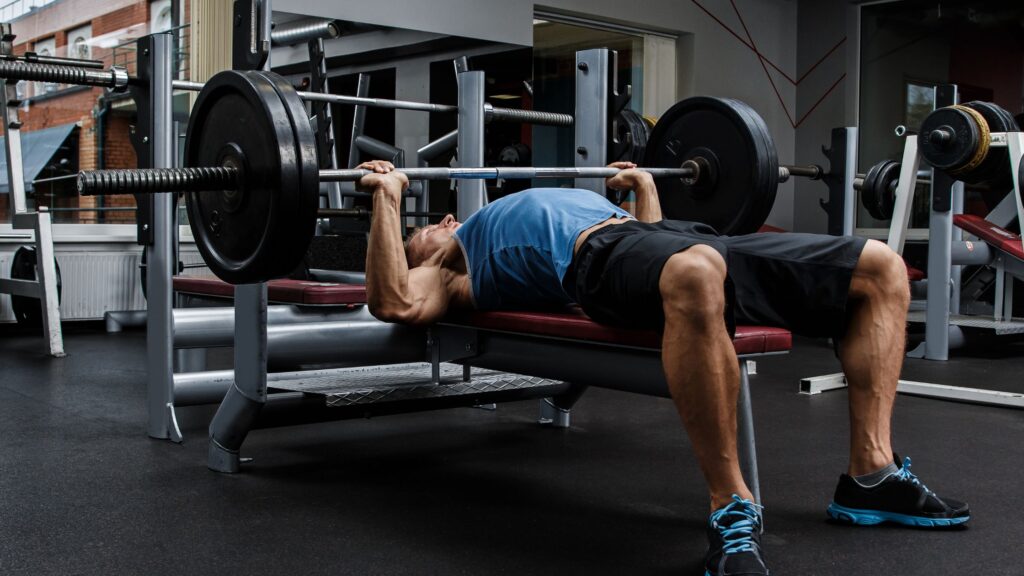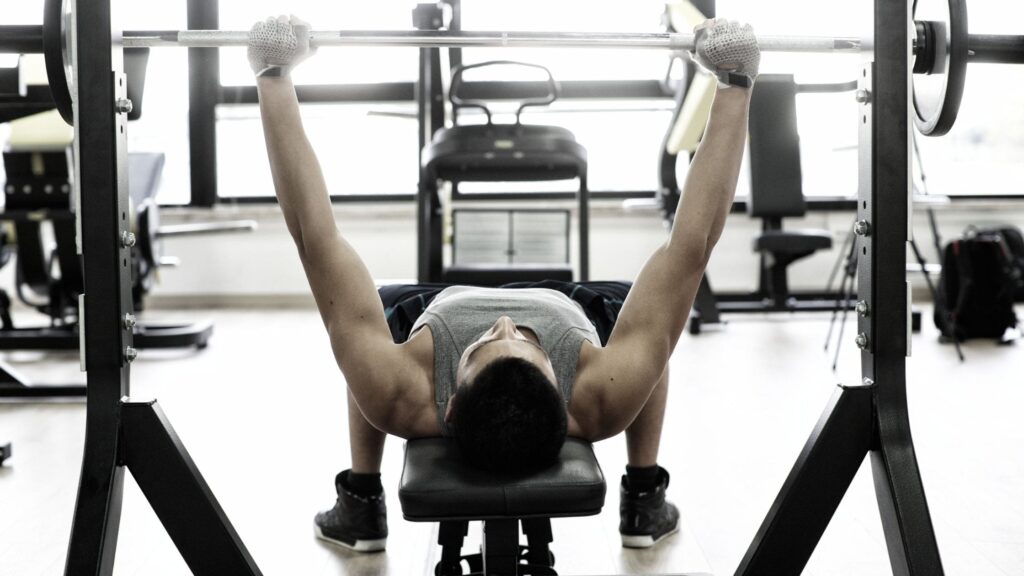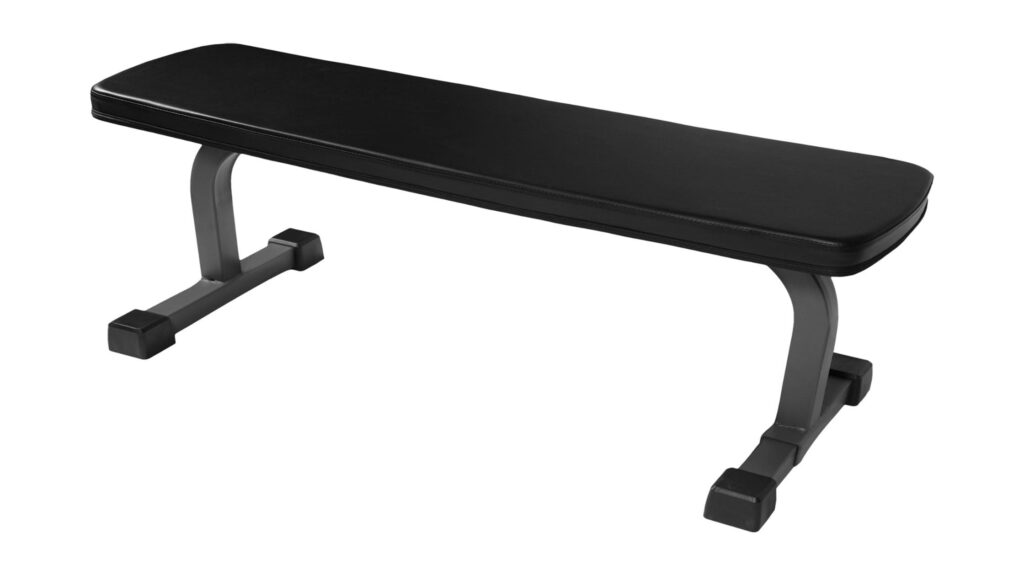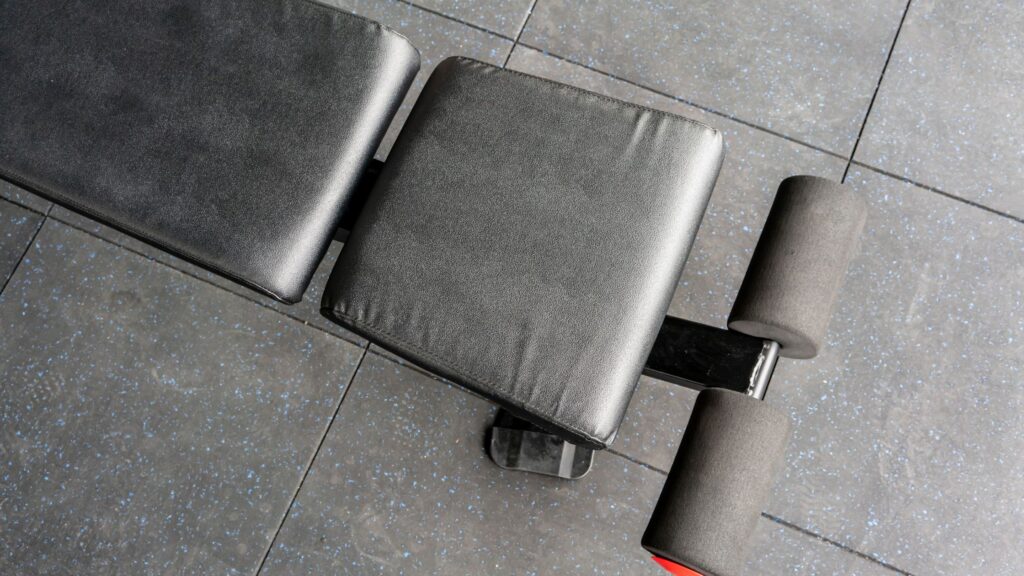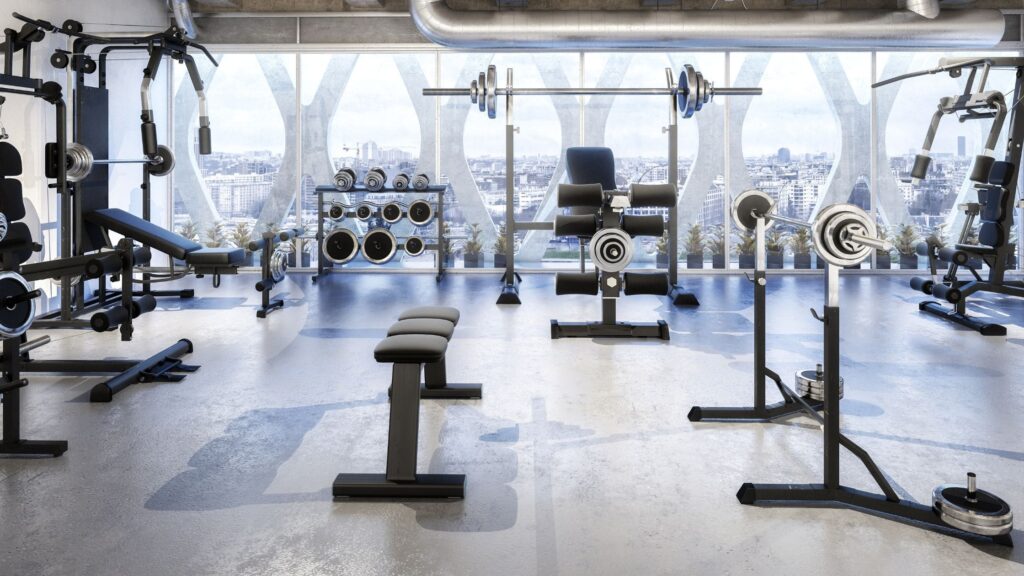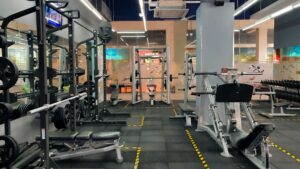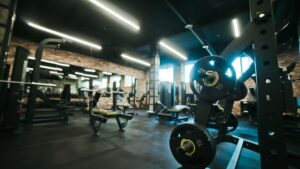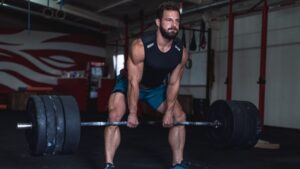When it comes to building strength and reaching your fitness goals, a weight bench is one of the most important pieces of gym equipment you can own, whether in your home gym or at a commercial facility.
From chest presses and Bulgarian split-squats to tricep dips and leg raises, a reliable bench supports a wide range of exercises that target different muscle groups effectively and safely.
Weight benches vary in price and quality. You might find a simple flat bench for around $50, while heavy-duty adjustable or Olympic benches with ratings over 1,000 lbs can cost $750 or more. These higher-rated benches offer superior construction, better padding, and features like incline, decline, and foldability for small spaces.
With so many options available, especially as home gym setups grow, understanding the types of weight benches and their capacities is crucial.
In this article, we’ll help you navigate these choices so you can find the right bench for your space, budget, and training needs.
What Is a Weight Bench?
A weight bench is a foundational piece of gym equipment designed to provide a secure, supportive platform for strength training exercises. It typically consists of a padded seat and back pad mounted on a rigid steel frame.
This structure allows you to perform a variety of movements, whether you’re lifting weights, doing bodyweight exercises, or using resistance bands as part of your workout routine.
The primary purpose of a workout bench is to elevate your body for better range of motion and to support your spine and shoulders. This setup enables you to maintain proper form, especially during exercises like the bench press or shoulder press. It also reduces the risk of injury by keeping your joints aligned and stable throughout the movement.
Many modern benches are compatible with Olympic barbells and adjustable accessories. They can serve as platforms for step-ups or even plyometric drills.
Whether you’re a beginner focused on basic exercises or someone building a full home gym setup, choosing the right weight bench is essential for progress and safety.
High-quality models use 11- to 14-gauge alloy steel frames, dense foam padding at least two inches thick, and antimicrobial vinyl to withstand repeated use, sweat, and chalk.
What are the Main Components of a Weight Bench?
A well-designed weight bench combines durability, comfort, and adjustability to meet various training goals.
Each component plays a key role in delivering a safe and effective workout experience, especially when dealing with heavy-duty routines or limited workout space.
- Frame: The frame is made from welded or bolt-together steel tubing, typically sized at 2″ × 3″. Commercial-grade benches often feature 11-gauge steel construction for added durability and stability. The base includes flared feet or rubber caps to prevent slipping and protect your floor surface, especially in home gyms with smooth flooring.
- Backrest & Seat Pads: The seat pad and back pad are constructed from high-density foam, generally 2–3 inches thick, and wrapped in abrasion-resistant PVC or vinyl. Some benches include antimicrobial treatments and double-stitched seams to extend longevity. The typical width for the backrest is 11–12 inches, and 8–10 inches for the seat, which suits a range of fitness levels and user sizes.
- Adjustment Mechanism: Adjustable weight benches use ladder-style notches or pop-pin systems for incline or decline positions. The best models are rated to handle over 600 pounds of shear force. Decline bench variants include serrated swing arms for secure angle locking, often ranging from −15° to −20°.
- Hardware & Fixings: Sturdy construction includes zinc-plated bolts, locking washers, and quick-release pull pins—especially important on folding bench designs that need frequent adjustments.
- Transport Features: Many benches offer rear wheels (typically 3–4 inches in diameter) and a front-mounted handle to improve portability. Folding benches for small spaces may include hinges that reduce their profile to under 8 inches, perfect for storing in compact workout areas.
How the gym bench is used in weight training?
A gym bench plays a central role in strength training by supporting your body in a stable position while you move through a variety of upper and lower body exercises. It forms the foundation for key compound lifts like the bench press, shoulder press, and dumbbell row. By anchoring your torso and enabling controlled force transfer, the bench enhances precision, range of motion, and muscle engagement during each rep.
With adjustable benches, you can modify angles from flat to incline and decline, which helps activate specific muscle groups—such as targeting upper chest fibers at 30–45° or shifting emphasis to the anterior deltoids at higher angles. Decline positions also support ab workouts and leg raises.
Benches are also used for split squats, step-ups, and mobility drills. In home gym setups, foldability becomes important for reclaiming floor space, while in commercial gyms, benches are integrated with larger equipment like power racks, Smith machines, or cable systems.
What are Different Types of Weight Benches?
The main weight bench types include flat, adjustable (FID), Olympic, folding, abdominal, preacher curl, utility, multifunctional/combo, and specialty variants. Understanding their differences can help you choose the right weight bench for your space, budget, and training goals.
Each type of bench varies in functionality. Some prioritize adjustability and angle variety, while others offer built-in attachments for targeted arm or core training.
A folding bench offers compact storage, whereas Olympic benches cater to heavier barbell work. Utility benches serve specific movement patterns with a backless or upright design.
Flat and adjustable benches dominate most home gym purchases due to their versatility and space efficiency.
Olympic and specialty benches, on the other hand, are more common in commercial gym environments where dedicated weight stations and higher weight capacity are essential. Choosing a weight bench involves weighing features like durability, support, exercise variety, and how well it fits your routine.
Flat Benches
A flat bench is a fixed-height workout bench with a horizontal back pad mounted on a steel frame. It is commonly used in both commercial and home gyms for foundational strength training.
Most flat benches feature a seat-to-floor height between 16 and 18 inches, with frame construction using 11- to 14-gauge steel to support loads ranging from 600 pounds to over 1,500 pounds. This high weight capacity makes it a reliable option for powerlifters and anyone focused on building raw strength without the need for incline or decline adjustments.
What sets a flat bench apart is its structural simplicity. There are no moving parts, which means fewer maintenance requirements and greater long-term durability.
It’s also lightweight enough to reposition easily during circuit training or when rearranging your workout area. However, it doesn’t offer angle variation, which limits the range of exercises that require backrest support or vertical pressing.
Pros:
- Stable, rigid platform ideal for heavy bench press or dumbbell work
- Lightweight (35–60 lb), easy to move and store
- Affordable, with models ranging from $50 (basic) to $400 (commercial grade)
- Minimal maintenance due to fixed design and no moving components
Cons:
- No incline or decline settings for angle-based training
- Lacks back support for seated exercises like shoulder presses or curls
- Requires a separate racking system for barbell lifts
- Offers limited exercise variety compared to adjustable benches
Adjustable Benches (FID Benches)
Adjustable benches, commonly known as FID benches, short for Flat, Incline, Decline, are highly versatile workout benches designed to support a broad range of strength training exercises.
These benches typically offer six to ten backrest positions ranging from flat (0°) up to around 85°, three seat angle settings, and some models include an optional decline position around −15°.
This adjustability allows you to target various muscle groups by changing angles, enhancing your ability to perform exercises like incline presses, shoulder presses, chest-supported rows, and decline crunches.
Pros:
- Combines three benches in one, saving valuable workout space
- Expands exercise options, enabling a wider range of pressing and core exercises
- Adjustment mechanisms, such as ladder or pin systems, support weight capacities between 600 and 1,000 pounds
- Ideal for beginners needing back support and athletes pursuing hypertrophy
Cons:
- Heavier (60 to 100 pounds) and larger footprint (52 to 56 inches in length)
- Moving parts require regular inspection and bolt tightening
- Some budget models may exhibit mid-lift wobble, affecting stability
Olympic Weight Benches
Olympic weight benches are designed specifically for heavy compound lifts, such as the bench press, and usually come with an integrated barbell rack. These benches feature a fixed or incline frame with wide uprights spaced to accommodate standard 7-foot Olympic barbells.
Adjustable J-cups allow for 2 to 4 height settings, and plate horns provide convenient on-board storage for weight plates. Built with commercial-grade 11-gauge steel, these benches handle total loads exceeding 1,000 pounds (including user weight).
Pros:
- Provides a safe and stable platform for max-effort lifts, especially for powerlifters
- Often includes safety bars for solo training sessions
- Requires minimal assembly and offers high durability for heavy daily use
Cons:
- Large footprint, typically over 78 by 50 inches, and heavy weight (110 to 180 pounds)
- Generally fixed in place and not portable
- Not compatible with shorter fitness bars, limiting some dumbbell exercises
- Price ranges from $300 to $800
What’s the Difference between Olympic and Standard Benches?
Olympic benches differ from standard models mainly in size, barbell compatibility, and support features. Olympic versions space their uprights to accept standard 2.2-meter (44-pound) bars and include wider, competition-spec pads about 12 inches wide to meet official standards.
They often come with integrated spotter platforms and plate pegs, providing convenience and safety for heavy lifting.
In contrast, standard benches usually depend on external racks or offer no rack at all, resulting in smaller rated weight capacities and narrower pad dimensions. While standard flat or FID benches offer better portability due to their simpler design, they lack the integrated support and storage features common in Olympic benches..
Folding Weight Benches
Folding weight benches are designed for portability and space-saving, making them perfect for home gyms with limited workout space or for anyone needing quick setup and teardown.
These benches use hinged frames that collapse to less than 8 inches thick. Some models can stand upright in a small footprint of about 20 by 20 inches or slide under a bed for convenient storage.
Most folding benches double as adjustable weight benches, offering flat, incline, and decline positions. They typically weigh between 40 and 55 pounds and often come with transport wheels for easier mobility. Prices range from $130 to $350, depending on steel gauge and adjustment features.
However, folding benches usually have lower weight capacities, between 300 and 600 pounds, and the additional joints may cause squeaks or wobble if not properly maintained. Assembly pins should be checked regularly to ensure safety. Despite these cons, they are a popular option for apartment dwellers or outdoor workouts where quick setup is essential.
Do folding benches compromise stability?
Stability in folding benches largely depends on the quality of the hinge mechanism and the bench’s foot spread. Premium folding benches include welded cross-braces and one-piece locking arms to reduce side-to-side sway.
Users lifting more than 300 pounds should look for models made from 14-gauge steel or thicker and equipped with dual-locking pop pins for enhanced security.
Rubberized feet help prevent slipping on smooth floors, further improving stability. While folding benches generally have more flex compared to welded flat benches, quality foldables hold up well during dumbbell exercises involving weights up to about 90 pounds per hand.
If you’re someone who prioritizes portability without sacrificing too much stability, a high-quality folding bench can be a practical addition to your home gym.
Abdominal Benches / Sit-Up Benches
Abdominal benches, also known as sit-up benches, feature a long, narrow pad that is permanently fixed at a decline angle between −15° and −30°.
These benches often include padded foot rollers to securely hold your ankles during core exercises.
Some models offer over ten angle stops, allowing you to progressively increase difficulty and target your abdominal muscles more effectively.
Pros:
- Superior activation of core muscles compared to standard floor crunches
- Reduces lumbar strain by supporting your thighs and hips
- Compact size, typically under 50 inches long, fitting well into small workout spaces
Cons:
- Limited usefulness for pressing or rowing exercises
- Lower weight capacity, usually up to 400 pounds
- May be redundant if you already own an adjustable bench with decline positions
Preacher Curl Benches
A preacher curl bench is designed specifically for isolated biceps training.
It consists of a seat and a 45° angled elbow pad that immobilizes the upper arms, ensuring strict form and maximum tension on the biceps during curls. Some models even include a built-in bar rack for convenience.
Pros:
- Eliminates shoulder sway, focusing tension solely on the biceps
- Adjustable seat height accommodates various limb lengths
- Compact footprint, typically around 3 square feet, making it space-efficient
Cons:
- Single-purpose design not suited for compound or multi-joint exercises
- Takes up space that might otherwise be used for more versatile equipment
- Costs typically range from $120 to $300
Utility Stools / Utility Benches
Utility stools or benches are backless workout benches standing 18 to 20 inches tall. Some variants offer a fixed 90° back support or foot pegs for additional stability during exercises.
These benches are often used for overhead presses, dumbbell curls, or as a plyometric step.
Pros:
- Very small footprint, approximately 20 × 20 inches, ideal for limited workout spaces
- Allows unhindered overhead pressing without back pad interference
- Doubles as a plyometric step or platform for bodyweight exercises
Cons:
- No recline or adjustable positions
- Limited to seated or standing support work, lacking versatility
- Price range is generally $80 to $200
Multifunctional / Combo Benches
Multifunctional benches combine the features of a flat or adjustable weight bench with built-in attachments such as leg curl stations, preacher pads, resistance band hooks, or even mini Smith machine tracks.
These benches transform a limited workout space into a full-body training station, making them a popular choice for home gym owners and beginners aiming for versatility without buying multiple pieces of equipment.
The leg developer attachment often includes 50 mm roller pads designed to accommodate weight plates up to 100 pounds. Preacher curl attachments enhance arm work, while high-pulley stations expand your exercise options with cable-based movements.
Despite their advantages, multifunctional benches come with trade-offs like a higher price range, typically $300 to $600, complex assembly, and moving parts that require regular maintenance.
Specialty Benches
Specialty benches refer to niche or advanced designs tailored to specific movements or mobility needs. This category includes vertical press benches, 45° back-extension benches, captain’s chairs, split-pad benches for hip thrusts, and decline-only models.
These benches are built to optimize ergonomics for particular lifts or accommodate users with limited range of motion.
Pros:
- Superior ergonomics and support for target muscle groups
- Often constructed with commercial-grade materials suitable for heavy-duty use
Cons:
- Generally expensive, ranging from $200 to $700 or more
- Tend to consume significant floor space due to specialized design
- Low cost-to-use ratio if your workout routine lacks the targeted exercises
How to Choose the Right Weight Bench for Your Needs
Begin by identifying your fitness objectives: Are you focused on strength training, hypertrophy, rehabilitation, or general fitness? This will guide your choice between flat benches, adjustable benches, or specialized models.
Next, consider your workout space. If you have limited room, folding benches or compact adjustable benches might be your best option. For powerlifters requiring heavy-duty support, flat or Olympic benches with high weight capacity are preferable.
Match the bench’s weight rating to your body weight plus the maximum weights you plan to lift, adding at least a 25% safety buffer to ensure durability and safety. When choosing an Olympic bench, confirm there is enough clearance for a standard 7-foot barbell.
Budget is another key factor. Entry-level benches typically cost under $150, mid-range options fall between $150 and $400, and professional-grade benches often exceed $400. Also, check the warranty length, frames with warranties over five years often indicate better build quality, and consider brand reputation and customer reviews.
Weight Capacity
Home gym benches generally support between 300 and 800 pounds, while commercial-grade benches often handle loads from 1,000 to 1,500 pounds or more. When assessing a bench’s capacity, you need to add your body weight to the heaviest amount of weights you plan to lift, then include a 10% safety margin.
Exceeding the rated capacity can lead to frame fatigue, increase the risk of injury, and may void the manufacturer’s warranty. This factor is crucial for strength training, especially if you are an athlete aiming for progressive overload or someone serious about lifting heavier reps. Always double-check the weight limit to ensure the bench supports your training goals safely and reliably.
Frame Material and Build Quality
Commercial and heavy-duty benches typically use 11- to 12-gauge steel, which is about 3 millimeters thick, offering excellent strength and support for weights up to and beyond 1,000 pounds.
For lighter home gym benches, 14-gauge steel is sufficient for weight capacities up to 600 pounds.
Continuous welding in the frame’s joints generally provides better structural integrity compared to spot welding, reducing flex and wear over time.
Look for closed-end frame caps that prevent moisture from entering and causing rust, which enhances the bench’s lifespan. High-quality frame construction is essential if you want a no-frills, heavy-duty bench that stands up to frequent, intense use.
Padding, Cushioning, and Upholstery
Comfort and safety during your workout largely depend on the quality of the bench’s padding and upholstery. Most quality weight benches feature 2 to 3 inches of high-density, firm foam padding designed to resist bottoming out, providing consistent support during presses, curls, and other exercises.
The upholstery often uses textured vinyl, which helps prevent slipping during movements like incline presses or shoulder presses, adding to your core stability and proper form.
Many benches include an antimicrobial coating on the upholstery, which combats mildew and extends the life of the padding, especially in home gyms where sweat and moisture accumulate. The combination of durable foam and resilient vinyl makes the bench comfortable for multiple rep ranges and varied exercises while ensuring longevity against wear and tear.
Adjustability Options
When choosing an adjustable weight bench, the number of seat and backrest positions directly impacts your workout versatility. Benches with seven or more backrest positions and at least three seat angles allow you to target muscle groups more precisely.
These various incline and decline settings help you adjust exercises like bench presses, shoulder presses, and decline presses to fit your training goals.
Pop-pin adjustment mechanisms offer quick angle changes, making them convenient for fast-paced workouts or circuit training. However, ladder-style systems provide a more secure, heavy-duty option for those lifting heavier weights or powerlifters.
If you’re someone who values both comfort and precise muscle activation, investing in a bench with finer adjustability can enhance your range of exercises and overall workout routine.
Size and Dimensions
The size of your weight bench plays a big role, especially if you’re working with limited workout space. A standard flat bench typically measures around 48 inches long, 12 inches wide, and about 17 inches high, a compact footprint that fits well in most home gyms.
Olympic benches, designed for serious lifting with barbells and safety racks, can exceed 80 inches in length, requiring more room for safe use. Folding benches are ideal if you need to save space; they collapse to a thickness of about 8 inches and can often be stored under a bed or against a wall.
When choosing, consider your workout area and whether you need foldability or a permanent setup to balance your space constraints with your fitness goals.
Attachments and Add-ons
Enhancing your bench with attachments can expand your workout options without needing extra equipment. Leg developers with 50 mm roller pads handle around 100 pounds and allow you to perform leg extensions or curls to target your quadriceps and hamstrings.
Preacher pads bolt onto the bench for focused biceps isolation during preacher curls, a staple for arm development.
Resistance band pegs, usually welded underneath adjustable benches, add versatility by incorporating bands into your routine, increasing muscle activation. Wheels are another useful add-on, providing portability so you can easily move your bench around your gym or storage area without compromising weight capacity.
Ease of Storage and Portability
When considering a weight bench for your home gym, ease of storage and portability are crucial, especially if space is limited. Aim for folding benches that weigh less than 60 pounds and include rear casters for easy movement.
These features help you roll your bench out for a workout and tuck it away quickly afterward, maximizing your workout space.
Look for benches with vertical-storage locking pins or compatible wall-mount brackets to further optimize space when the bench is not in use. Such foldability and portability make the right weight bench a practical choice for anyone balancing fitness goals with small workout areas.
Training Goals
Your training goals should directly influence the type of bench and accessories you choose. If strength training is your priority, focus on benches with high weight capacity and solid construction. For hypertrophy, adjustable benches with multiple incline and decline positions help target different muscle groups.
Beginners or general fitness enthusiasts may prefer folding benches that are versatile and space-saving. Rehab-focused users often benefit from utility benches or stools offering extra support and adjustability.
When looking for quality options, you can find a wide range of reliable and affordable gym weight benches for sale at Best Used Gym Equipment, featuring trusted brands and different types of weight benches to suit your workout routine.
What are the Best Weight Benches for Specific Training Goals?
For strength training, a flat or Olympic bench rated for 1,000 pounds or more is ideal to support heavy lifting and bench presses. If hypertrophy is your focus, adjustable benches with 7 or more backrest positions and preacher curl attachments allow for varied angles and isolation exercises.
General fitness users benefit most from folding combo benches that provide a wide range of exercises while saving space. For rehabilitation and mobility, a utility stool with high back support and an adjustable seat that reclines to 85 degrees or more offers the comfort and stability needed during recovery.
What are the Best Weight Benches for Home Gym?
When choosing the right weight bench for your home gym, prioritizing foldability and versatility is essential. Adjustable weight benches with folding designs that weigh under 55 pounds are ideal for easy storage and moving, especially if space is limited.
Look for benches with rear wheels to improve portability without sacrificing stability. A solid weight capacity rating of around 600 pounds ensures you can handle heavy lifts safely as you progress.
Additionally, a warranty of at least three years reflects confidence in durability and materials. Folding FID benches that allow flat, incline, and decline positions provide you the range of exercises needed to target different muscle groups effectively.
What are the Best Weight Benches for Commercial Gym Use?
In commercial gyms, durability and heavy-duty performance come first. Choose welded 11-gauge steel frames that offer exceptional strength and stability, able to handle daily use and user weights plus heavy plates with ratings often reaching 1,500 pounds.
Commercial-grade benches, including flat benches and Olympic weight benches with integrated racks, feature antimicrobial foam padding designed to withstand wear and tear, sweat, and frequent cleaning. Replaceable wear parts, such as pads and hardware, extend the bench’s life and reduce downtime.
These benches support a broad range of training goals from strength training to hypertrophy and accommodate high-rep routines by athletes and fitness enthusiasts alike.
What are the Benefits of Using Gym Benches?
Incorporating a weight bench into your workout routine unlocks a wide range of physical and functional benefits. With over 30 press and row variations available, a bench dramatically expands your exercise options.
The stable base of a gym bench improves joint stacking and proper form, reducing injury risk during strength training. By adjusting angles, flat, incline, or decline, you can target upper, mid, and lower chest muscle groups more effectively.
Unlike floor lifts, using a bench reduces shear forces on your spine, providing safer movement patterns. Additionally, gym benches double as rehab platforms, offering controlled range of motion for recovery exercises.
Whether you’re a beginner or an experienced athlete, an adjustable weight bench enhances your workout routine’s versatility, allowing you to tailor reps and exercises to your fitness goals with improved comfort and safety.
What Exercises You Can Do With a Weight Bench?
A weight bench opens up a wide range of workout possibilities, letting you target different muscle groups effectively:
- Classic bench press variations, flat, incline, and decline, are staples for building chest strength and size.
- You can also perform dumbbell rows to engage back muscles and step-ups for lower body power and balance.
- Triceps dips using the bench edge isolate arm muscles, while Bulgarian split-squats challenge your legs and core stability.
- For shoulder development, seated shoulder presses and chest flys allow targeted muscle activation. Reverse flys strengthen rear deltoids and upper back.
- Core exercises like sit-ups and leg raises are easy on ab benches, and the bench doubles as a platform for hip thrusts, improving glute strength.
- Beyond lifting weights, the bench supports stretching routines and bodyweight exercises such as push-ups and tricep dips.
How Weight Benches Fit Into a Full-Body Workout Routine?
Weight benches integrate smoothly into a balanced training plan covering upper body, core, and lower body.
For example, you can follow a push-pull-legs split using an FID bench: perform chest presses and shoulder presses on incline or flat positions for push days; target back with dumbbell rows on pull days; and use the bench for Bulgarian split-squats, step-ups, and hip thrusts on leg days.
Core workouts like sit-ups or leg raises can be added as accessory exercises anytime.
The bench’s adjustability helps you tailor seat and backrest positions to fit your form and range of motion. Using a single adjustable weight bench can save space and simplify your workout setup while targeting multiple muscle groups efficiently throughout your full-body routine.
What are Safety Considerations When Using a Weight Bench?
Choosing the right bench involves more than just price or style; stability, weight capacity, and proper setup are essential to prevent injury and maximize performance. Ensuring the bench is sturdy and rated for your body weight plus the weights you plan to lift helps maintain structural integrity and avoid frame fatigue.
Always check that the bench is securely assembled and that bolts are tight to reduce wobble. When lifting heavy, using a spotter or safety bars can protect you during challenging reps.
Whether you’re training for strength, hypertrophy, or rehab, a focus on safety supports consistent progress toward your fitness goals while reducing risks associated with improper form or equipment failure.
Ensuring Bench Stability
To guarantee a stable workout bench, place it on a flat, even surface. Uneven floors can cause wobbling, which risks injury and affects your form. Regularly inspect and tighten all bolts and screws, ideally once a month, to maintain the bench’s rigidity.
If your workout space has slick flooring, using rubber mats beneath the bench helps prevent unwanted sliding.
Stability is especially important for adjustable benches where multiple incline and decline positions might introduce movement. This simple routine extends the durability of your equipment while providing the firm support you need for exercises like bench presses and shoulder presses.
Avoiding Weight Overload
Adhering to your bench’s weight capacity rating is vital for safety and longevity. Always stay about 10% below the maximum rated load to maintain a safety margin. This total should include your body weight plus the weights you lift during exercises.
Ignoring this can cause frame damage, increase wear and tear, and void warranties. If you’re consistently pushing personal records and your current bench approaches its limits, it’s time to upgrade to a model with a higher weight capacity.
Heavy-duty benches, especially commercial-grade ones, typically offer ratings of 1,000 lbs or more to support serious athletes and heavy lifting routines safely.
Using Proper Form and Technique
Using the right form on any weight bench, whether flat, fid benches, or utility benches, is key to preventing injuries. Improper positioning can strain your back, shoulders, or wrists during exercises like bench presses or tricep extensions.
Focus on controlled movements, steady rep speed, and maintaining proper alignment of your body and the bench’s back pad. For example, arching your back correctly during chest presses recruits the right muscle groups while protecting your spine. Good form also improves your strength training results by maximizing muscle engagement with each lift.
Using a Spotter for Heavy Lifts
When lifting heavy weights, especially on Olympic weight benches or flat benches with heavy-duty ratings, having a spotter is crucial. A spotter provides physical assistance and ensures safety during difficult reps or near failure sets.
They can help with unracking and re-racking the barbell, reducing the risk of injury. For home gym users pushing personal records, a spotter increases confidence and allows safe progression.
If you train alone, consider safety bars or adjustable racks as a backup. Spotters play a key role in exercises like military presses, bench presses, and heavy dumbbell rows.
Keeping the Workout Area Clear
Maintaining a clutter-free workout space around your weight bench prevents trips and falls.
Ensure there’s enough floor space around folding benches or flat benches for easy access to weights and movement during exercises like step ups or Bulgarian split squats. Store dumbbells, weight plates, and accessories like preacher curl attachments properly to avoid hazards. Using a gym mat can protect flooring and prevent slipping.
A tidy workout area enhances your workout routine and safety, allowing you to focus fully on your training goals and reps without worrying about accidental injuries from clutter or equipment placement.
Routine Bench Inspections
Regular inspections of your weight bench are crucial to keep your home gym safe and functional. Check all screws and bolts monthly to ensure nothing has loosened, especially if you use adjustable benches or folding benches frequently. Inspect the back pad and seat pad for wear or damage, as cushioning plays a big role in comfort and support during bench exercises.
Examine the frame for signs of wear, cracks, or rust, particularly on commercial-grade or heavy-duty benches rated for 1,000 lbs or more. Staying vigilant with maintenance extends your bench’s lifespan and ensures every rep is done on a stable, reliable platform.
Warming Up Before Lifting
Warming up is a non-negotiable part of a safe workout routine involving any type of weight bench. Start with dynamic stretches targeting the muscles you plan to engage, such as shoulder circles before a shoulder press or leg swings before step ups.
Gradually increase the load by performing lighter sets on your adjustable weight bench, moving through flat, incline, or decline positions to prep your muscles and joints. This approach improves blood flow, enhances muscle activation, and reduces injury risk during heavier lifts like bench presses or dumbbell rows.
How to Set Up Your Weight Bench Correctly?
Here is our five step process to set up a weight bench for proper workout and form:
- Begin by selecting the right type, flat, fid benches, or adjustable benches with incline and decline positions, based on your training goals and available workout space.
- Secure all attachments, such as preacher curl benches or leg developers, ensuring they fit snugly and won’t shift during use.
- Position the bench on a stable, flat surface to avoid wobbling; home gym owners should consider rubber mats for extra grip.
- Adjust the backrest and seat to appropriate angles to target the intended muscle groups while maintaining proper form.
- Confirm enough clearance around the bench for movements like step ups or dumbbell presses, and keep weights organized to prevent trips or falls.
What are Maintenance Tips for Prolonging the Life of a Weight Bench?
Taking care of your weight bench ensures it stays reliable and safe for your workouts, whether you use a flat bench, adjustable weight bench, or fid benches:
- Always wipe down sweat and moisture after each session to prevent damage to the foam padding and vinyl upholstery.
- Monthly, check and tighten all bolts and screws to maintain frame stability and durability.
- Store your bench indoors to avoid rust and wear from excessive moisture.
- Periodically condition vinyl pads to keep them supple and resistant to cracking.
- Lubricate hinges on adjustable benches to ensure smooth movement of incline and decline positions.
- An annual upholstery inspection helps catch wear and tear early, preserving comfort and safety for your full range of exercises.
What are the Price Ranges and Budget Considerations of Different Types of Weight Benches?
Flat benches typically range from $50 to $400, with budget models offering no-frills steel frames and basic foam padding, while premium options provide heavy-duty steel, high-quality upholstery, and better weight capacity.
Adjustable benches command $150 to $600, adding versatility with multiple incline, decline, and flat positions, higher-grade materials, and attachments like preacher curl benches or leg developers.
Olympic benches and multifunctional models start around $300 and can exceed $800, featuring thick 11-gauge steel, commercial-grade durability, superior padding, and warranty support.
Your budget influences your choice, but investing in durability and weight capacity ensures your bench supports your fitness goals, from beginner to athlete levels
What are the Alternatives to Weight Benches?
While weight benches are a staple, several alternatives offer variety for your workout routine.
Stability balls can replace benches for core exercises and balance training, engaging multiple muscle groups.
Floor presses let you simulate bench press motions without equipment, ideal for limited space or beginners. Plyo boxes provide versatile platforms for step-ups, tricep dips, and plyometric training, targeting legs and arms effectively.
Resistance bands are portable and versatile, offering resistance for pressing, rowing, or leg exercises without bulky gym equipment. These substitutes complement your regimen and can be especially useful in small spaces or as budget-friendly options.
Conclusion
Choosing the right weight bench is more than just picking a piece of gym equipment, it’s about setting yourself up for success in your fitness journey. When we invest time in understanding the different price ranges and features, we can find the perfect balance between what fits our budget and what meets our training goals.
Taking care of your bench with simple maintenance, like wiping it down and checking bolts, helps it last longer and keeps your workouts safe and comfortable.
If you’re working with limited space or a tighter budget, don’t worry,there are plenty of alternatives like resistance bands or stability balls that can keep your routine fresh and effective.
Whether you’re using a compact folding bench at home or a heavy-duty Olympic bench at the gym, the key is quality and care. When you feel confident in your equipment, you can focus on what really matters, getting stronger, improving your form, and enjoying every rep. So let’s make sure your bench is the reliable partner you deserve on this journey to better fitness!


